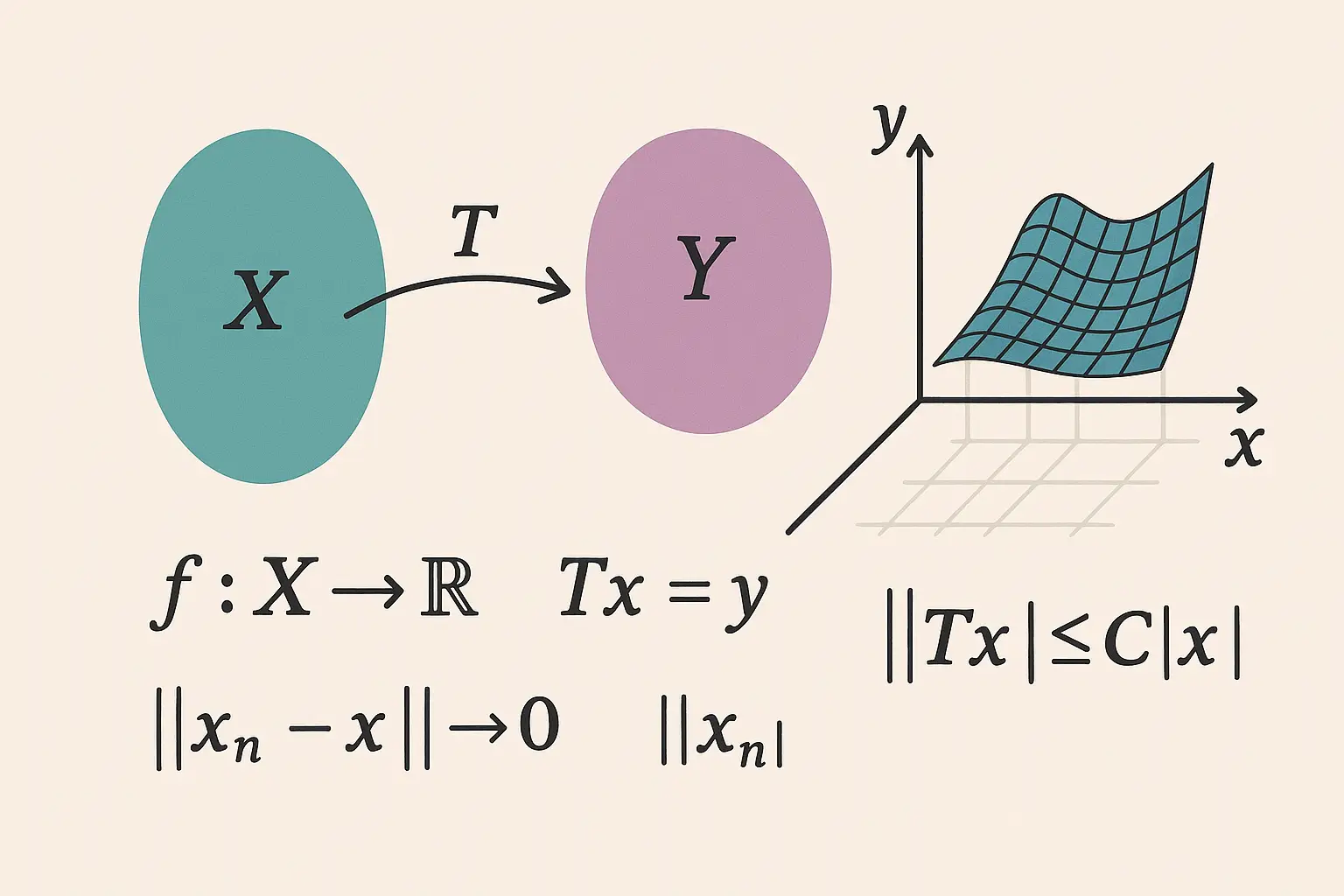Table of Contents
- Introduction
- What Is Functional Analysis?
- Normed and Banach Spaces
- Inner Product and Hilbert Spaces
- Linear Operators and Functionals
- Bounded and Unbounded Operators
- Dual Spaces and the Hahn–Banach Theorem
- The Riesz Representation Theorem
- Compact Operators and Spectral Theory
- Self-Adjoint, Unitary, and Normal Operators
- Hilbert–Schmidt and Trace Class Operators
- Fourier Analysis in Hilbert Spaces
- Applications to PDEs and Quantum Mechanics
- Weak and Strong Convergence
- Conclusion
1. Introduction
Functional analysis generalizes linear algebra and calculus to infinite-dimensional vector spaces. It is the mathematical foundation of quantum mechanics, partial differential equations (PDEs), and signal processing. It brings together vector spaces, topology, and linear operators in a unified framework.
2. What Is Functional Analysis?
Functional analysis studies vector spaces of functions and linear operators acting on them. Central themes include:
- Infinite-dimensional spaces
- Continuity and boundedness
- Spectral theory of operators
- Duality and convergence
3. Normed and Banach Spaces
A normed vector space \( (X, |\cdot|) \) is a vector space with a norm satisfying:
- \( |x| \ge 0 \), and \( |x| = 0 \iff x = 0 \)
- \( |\alpha x| = |\alpha||x| \)
- \( |x + y| \le |x| + |y| \) (triangle inequality)
A Banach space is a complete normed space — all Cauchy sequences converge.
4. Inner Product and Hilbert Spaces
An inner product \( \langle x, y \rangle \) satisfies:
- \( \langle x, x \rangle \ge 0 \)
- \( \langle x, x \rangle = 0 \iff x = 0 \)
- \( \langle x, y \rangle = \overline{\langle y, x \rangle} \)
- Linearity in the first argument
The induced norm is \( |x| = \sqrt{\langle x, x \rangle} \)
A Hilbert space is a complete inner product space.
5. Linear Operators and Functionals
A linear operator \( T: X \to Y \) satisfies:
\[
T(\alpha x + \beta y) = \alpha T(x) + \beta T(y)
\]
A functional is a map \( f: X \to \mathbb{F} \) (usually \( \mathbb{R} \) or \( \mathbb{C} \)).
6. Bounded and Unbounded Operators
- Bounded: there exists \( C > 0 \) such that \( |Tx| \le C|x| \)
- Unbounded: no such constant exists; common in differential operators
Bounded operators are continuous; unbounded ones must be treated carefully.
7. Dual Spaces and the Hahn–Banach Theorem
The dual space \( X^* \) consists of all bounded linear functionals on \( X \).
Hahn–Banach Theorem: extends a bounded functional from a subspace to the whole space without increasing the norm.
8. The Riesz Representation Theorem
For a Hilbert space \( H \), every bounded linear functional \( f \in H^* \) is uniquely represented as:
\[
f(x) = \langle x, y \rangle \quad \text{for some } y \in H
\]
This establishes an isomorphism between \( H \) and \( H^* \).
9. Compact Operators and Spectral Theory
A compact operator maps bounded sets to relatively compact sets. In Hilbert spaces, these operators resemble matrices with countable spectra.
Spectral theory studies eigenvalues and eigenvectors of operators:
- Spectrum \( \sigma(T) \): generalization of eigenvalues
- Resolvent set: \( \lambda \in \mathbb{C} \) where \( (T – \lambda I)^{-1} \) exists
10. Self-Adjoint, Unitary, and Normal Operators
- Self-adjoint: \( T = T^* \)
- Unitary: \( T^T = TT^ = I \)
- Normal: \( TT^* = T^*T \)
Self-adjoint operators correspond to observables in quantum mechanics.
11. Hilbert–Schmidt and Trace Class Operators
- Hilbert–Schmidt: \( \sum |Te_n|^2 < \infty \)
- Trace class: \( \sum \langle Te_n, e_n \rangle < \infty \)
These operators are compact and play a role in quantum statistical mechanics.
12. Fourier Analysis in Hilbert Spaces
In \( L^2(\mathbb{R}) \), functions can be expanded as orthonormal sums:
\[
f(x) = \sum_{n} \langle f, e_n \rangle e_n(x)
\]
Fourier basis provides a canonical orthonormal set in function spaces.
13. Applications to PDEs and Quantum Mechanics
- Weak solutions to PDEs
- Variational methods and Sobolev spaces
- Quantum observables as self-adjoint operators
- Schrödinger equation in Hilbert space form
- Spectral decomposition and time evolution
14. Weak and Strong Convergence
- Strong convergence: \( |x_n – x| \to 0 \)
- Weak convergence: \( f(x_n) \to f(x) \) for all \( f \in X^* \)
Weak convergence is weaker but still useful in compactness and variational problems.
15. Conclusion
Functional analysis provides a rigorous mathematical framework for studying infinite-dimensional systems and operators. It is indispensable in quantum mechanics, PDE theory, and modern applied mathematics. Mastery of its basic concepts is a gateway to understanding advanced theoretical frameworks in both physics and analysis.


